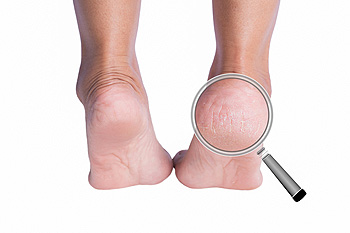
People who enjoy running can experience many benefits including increased endorphins. Conversely, avid runners may see they have developed cracked heels, which can cause pain and discomfort while making it difficult to run. There are generally four stages that runners see when developing cracked heels, which begin with their feet becoming red, sensitive, and dry. This can be followed by an itchy and burning sensation, which can lead to cracked and peeling skin. If treatment is not started, the cracks in the skin may begin to bleed, causing the feet to look unattractive. A common reason for cracked heels to develop is a lack of hydration of the skin. Cracked heels found in runners are often increased as a result of the impact of running, and from wearing socks and shoes that may become sweaty. If you have developed this foot condition, it is suggested that you consult with a podiatrist who can guide you toward the treatment method that is correct for you.
If the skin on your feet starts to crack, you may want to see a podiatrist to find treatment. If you have any concerns, contact Dean Kim, DPM from Greater Texas Foot & Ankle Specialist. Our doctor can provide the care you need to keep you pain-free and on your feet.
Cracked Heels
It is important to moisturize your cracked heels in order to prevent pain, bleeding, and infection. The reason cracked heels form is because the skin on the foot is too dry to support the immense pressure placed on them. When the foot expands, the dry skin on the foot begins to split.
Ways to Help Heal Them
- Invest in a good foot cream
- Try Using Petroleum Jelly
- Ease up on Soaps
- Drink Plenty of Water
Ways to Prevent Cracked Heels
- Moisturize After Showering
- Skip a Shower
- Keep Shower Water Lukewarm
- Don’t Scrub Your Feet
If you are unsure how to proceed in treating cracked heels, seek guidance from a podiatrist. Your doctor will help you with any questions or information you may need.
If you have any questions, please feel free to contact our office located in Frisco, TX . We offer the newest diagnostic and treatment technologies for all your foot care needs.





